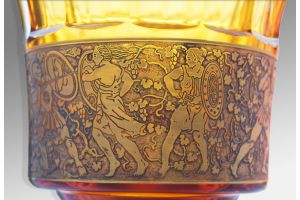Leo Moser Vase
An Art Deco Period Etched Amber Glass Vase by Leo Moser.
The flaring rim above a relief-cut panel highlighted in gilt, depicting Amazon warriors above a multi-faceted body.
The underside signed in script, ‘Moser, Carlsbad, made in Czechoslovakia’. Circa 1925.
Perfect condition.
18cm high 19.5cm diameter
7" high 7.6" diameter
The Moser glass factory was named after Ludwig Moser (1833-1916) and established in Karlsbad (now Karlovy Vary) in North East Bohemia in 1857. Moser glass first became famous for the quality of engraved decoration. He employed brilliant engravers including Edward and Johann Hoffman. The engravers followed long established Bohemian design themes of hunts, stags and wooded landscapes, which appealed to the indigenous population of Bohemia. Moser was also influenced by European art movements and produced designs inspired by European Baroque works, Japanese ceramics and Islamic goldsmiths. During this period Moser was solely concerned with the decoration of glass, the glass blanks being bought in from other manufactories, such as Meyrâes Neffe and Kralik.
In the 20th Century Moser produced a new range of glass called Alexandrit. This is unusual glass because like the stone alexandrite it can change colour and yet is man made.
The flaring rim above a relief-cut panel highlighted in gilt, depicting Amazon warriors above a multi-faceted body.
The underside signed in script, ‘Moser, Carlsbad, made in Czechoslovakia’. Circa 1925.
Perfect condition.
18cm high 19.5cm diameter
7" high 7.6" diameter
The Moser glass factory was named after Ludwig Moser (1833-1916) and established in Karlsbad (now Karlovy Vary) in North East Bohemia in 1857. Moser glass first became famous for the quality of engraved decoration. He employed brilliant engravers including Edward and Johann Hoffman. The engravers followed long established Bohemian design themes of hunts, stags and wooded landscapes, which appealed to the indigenous population of Bohemia. Moser was also influenced by European art movements and produced designs inspired by European Baroque works, Japanese ceramics and Islamic goldsmiths. During this period Moser was solely concerned with the decoration of glass, the glass blanks being bought in from other manufactories, such as Meyrâes Neffe and Kralik.
In the 20th Century Moser produced a new range of glass called Alexandrit. This is unusual glass because like the stone alexandrite it can change colour and yet is man made.
REFERENCE: 2010moservase








